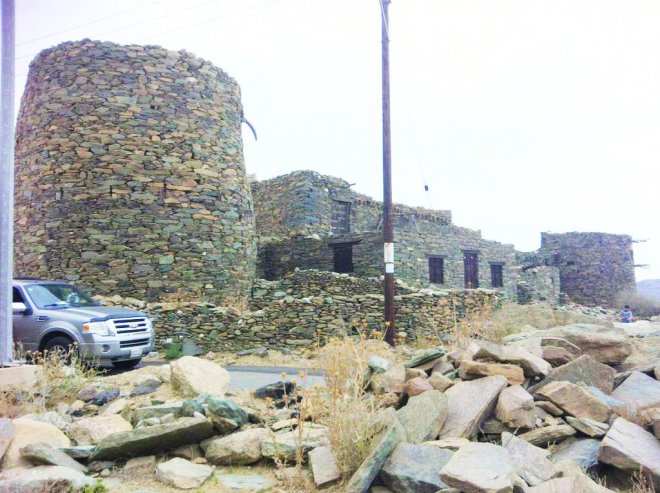Bakhroosh bin Alas Castle from the heritage of Al Baha region
on- 2021-12-07 14:25:23
- 0
- 6280

Reason of nomenclature:
The castle is attributed to Prince Bakhrush bin Alas Al-Zahrani, one of the leaders of the first Saudi state. He built the castle in 1228 AH, during the reign of the first Saudi state, for military purposes to confront the Ottoman invasion of the Arabian Peninsula and to be the place of his emirate.
A brief summary of Prince Bakhroosh bin Alas:
Name: Bakhroosh bin Alas Al-Zahrani.
Date of birth: 1170 AH.
Place of Birth: Al-Hassan Village.
Rank: Prince, Ruler, Knight.
Education status: Able to read and write.
Legal capacity: appointed Emir of Taif by order of Imam Abdul Aziz bin Muhammad bin Saud (Source: Saudi Ministry of Foreign Affairs)
History of his emirate in Zahran: He assumed the entire emirate of Zahran in 1218 AH, and it lasted for 12 years until the date of his murder in 1230 AH.
The headquarters of the Emirate: the village of Al-Hassan, which includes the mosque, the well, the trench, the horse stable, the watchtower, and the military forts.
His death: He was murdered, may God have mercy on him, in 1230 AH at the age of 60 years.
Place of death: Al-Qunfudhah.
The events before his death: he was treacherously captured, and he was freed from the hands of the Ottoman treachery, and the guard was killed and five with him, and they were able to catch him and return him to his tent with his companion, Prince Tami bin Shuaib. They did not kill him directly, but continued to stab him with spears and arrows, and he did not groan in pain until he died of bleeding, may God have mercy on him. Muhammad Ali Pasha received messages of congratulations from the Ottoman Empire for his killing of Bakhrush!!
Adapted from (Title of Glory in the History of Najd Book, Othman Bin Abdullah Bin Bishr)
Historians say regards him:
John Louis Burckhardt, the Swiss historian, said:
Bakhrush is one of the wisest Wahhabi leaders.
Giovanni Vinati, the Italian historian, said:
“The Arabs did not witness braver than Bakhrush in his time.”
The location of the castle: It is located in the village of Al-Hassan in the Al-Qura Governorate, in the north of Al-Baha region, in a distinguished location, elevated from its surroundings, carefully chosen on four facades.
Castle Description
First: the center of the castle:
The castle is almost square in shape surrounded by a wall estimated at about 2000 square meters, located in the two southern corners of it are two circular-shaped war forts that are still in their old condition, consisting of three floors in each fortress, about 70 holes for archers designed in an engineering and tactical manner that provide protection for the archers and expose the entire surrounding area.
The northern side of the castle is fortified with a wall, overlooking a slope that is difficult for the enemy to break into. Several buildings belonging to the castle are linked to the wall.
In the center of the castle is a square-shaped fortress that is considered the beating heart of the castle. It consists of five floors, of which three floors remain. This tower is distinguished by its white color and elaborate construction, and the stones used in its construction in terms of type and large size compared to the rest of the other buildings, and it has openings for observation and shooting.
Inside the castle there is a circular pool with a diameter of about 4 meters from the top and a graduated depth of about 6 meters below the surface of the ground, which was used to store water inside the castle.
Inside the castle there is a fortified building called the House of Money. It is characterized by the absence of windows, and it has only one entrance. It was used to store money, livelihoods, grain and food supplies to the castle.
The castle contains horse stables, weapons stores, soldiers' camps, and guest boards.
The castle also contains several buildings, formations, corridors and secret doors to move between its interior parts.
A circular fortress was recently built in the northwest corner of the citadel, similar to the main forts.
Second: The external parts of the castle:
The southeastern fortress: It is connected to the castle and is circular in shape, consisting of two floors, and it has about 40 shooting holes, with a wall attached to it from the eastern side and a wall from the southern side. It is the first line of defense to protect the trench and the water resource (the well of Rahwa).
The Trench: connects the southeastern fortress with the well (its features have disappeared due to urban development).
Cemeteries: They are located on the southeastern side, and there are four cemeteries, in which the dead of the Ottomans were buried in the Battle of Wadi Quraish, which took place next to the castle in 1230 AH.
Bakhroush bin Alas Palace: It is considered a private residence for him, located on the eastern side of the castle, consisting of two floors with three facades surrounded by courtyards and walls, and it is independent and not linked to any other building.
Subul Al-Sultan: It is located in the south of the castle and is considered one of the main roads in the village, linking the east and west of the village.
Third: The area surrounding the castle:
The area surrounding the castle contains archaeological houses and forts for the people of the village. The most prominent of these forts is a fortress called (Hubeish Fort) located on the southwestern side of the castle in a square shape, from which two floors remain, and another fort called (Nabet Fort) located on the western side of the castle It consists of five floors and has a square shape.
It contains the ancient mosque that was demolished and a modern mosque was built in its place, and it has many corridors, roads and squares.
Among the most important historians who wrote about Bakhroosh bin Alas:
The Swiss Burckhardt in his book (Journeys in the Arabian Peninsula).
Italian traveler Giovanni Vignati (Adventures in Arabian Peninsula).
British explorer Geralt de Gauri writing (The Rulers of Mecca).
French explorer Maurice Tamiset.
Othman bin Abdullah bin Bishr, his book (The Title of Glory in the History of Najd)
